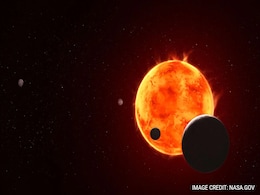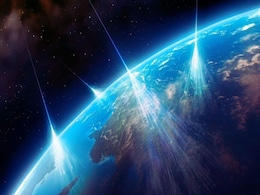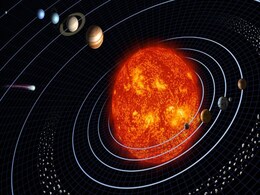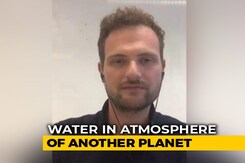Earth Like Planet
- All
- News
- Videos
- Web Stories
-

NASA's Astronomers Reveal Red Giant Stars May Destroy Their Own Planets
- Monday November 10, 2025
- Science | Edited by Astitva Raj
This extreme expansion poses a serious threat to nearby planets. For example, when the Sun becomes a red giant in about 5 billion years, it will likely swallow Mercury and Venus.
-
 www.ndtv.com
www.ndtv.com
-

Scientists Stunned as Earth’s Magnetosphere Shows Reversed Electric Charge Patterns
- Sunday November 2, 2025
- Written by Gadgets 360 Staff
Scientists have discovered that Earth’s morning-side magnetosphere is negatively charged, overturning decades of assumptions about space electricity. Satellite data and simulations show the charge pattern flips near the equator but remains traditional at the poles. The breakthrough reshapes understanding of space weather and may also clarify elec...
-
 www.gadgets360.com
www.gadgets360.com
-

Ryugu Samples Reveal Ancient Water Flow on Asteroid for a Billion Years
- Saturday October 18, 2025
- Written by Gadgets 360 Staff
Microscopic samples from asteroid Ryugu reveal that liquid water once flowed through its parent body long after its formation. The finding, led by University of Tokyo scientists, suggests that such asteroids may have delivered far more water to early Earth than previously thought, offering a new perspective on how our planet’s oceans originated.
-
 www.gadgets360.com
www.gadgets360.com
-

Astronomers Detect Hints Of Hidden Earth-Sized Planet Beyond Neptune
- Wednesday October 15, 2025
- Written by Gadgets 360 Staff
Astronomers propose the existence of ‘Planet Y’, a hidden Earth-size planet that may orbit closer than the theorized ‘Planet Nine’. Based on Kuiper Belt object patterns, the study suggests a rocky world influencing orbital tilts. Experts remain divided, but upcoming sky surveys could soon confirm or rule out its existence.
-
 www.gadgets360.com
www.gadgets360.com
-

Not Like Venus Or Mars, Distant Exoplanet May Have Atmosphere Like Earth's
- Friday September 19, 2025
- World News | Edited by NDTV News Desk
A distant exoplanet might have an atmosphere similar to Earth's, early observations from the James Webb Space Telescope (JWST) suggest. It is part of a group of planets orbiting a star called TRAPPIST-1, about 40 light-years away from Earth.
-
 www.ndtv.com
www.ndtv.com
-

New 'Quasi-Moon' Discovered in Earth Orbit May Have Been Hiding There for Decades
- Sunday September 14, 2025
- Written by Gadgets 360 Staff
Astronomers have identified asteroid 2025 PN7 as a possible quasi-moon of Earth, trailing our planet for nearly 70 years. At just 62 feet wide, it is the smallest and least stable quasi-satellite detected so far. Researchers believe advanced observatories like the Vera Rubin Observatory could uncover more hidden companions in Earth-like orbits
-
 www.gadgets360.com
www.gadgets360.com
-

NASA Missions Uncover a Diverse Galaxy of Super-Earths, Raising New Questions About Planetary Evolution
- Thursday August 14, 2025
- Written by Gadgets 360 Staff
Super-Earths are among the most common planets in the galaxy, yet none exist in our solar system. Larger than Earth but smaller than Neptune, they range from ocean-covered worlds to scorched, atmosphere-less rocks. Some orbit within habitable zones, making them prime candidates for life. NASA’s Kepler and TESS missions, along with upcoming telesc...
-
 www.gadgets360.com
www.gadgets360.com
-

Scientists Explore Role of Space Radiation in Powering Alien Microbial Life
- Wednesday August 6, 2025
- Written by Gadgets 360 Staff
A new study proposes that life may exist far from sunlight in a “radiolytic habitable zone” deep beneath the icy surfaces of Mars, Europa, and Enceladus. Cosmic rays, which can penetrate rock and ice, break water molecules apart to release hydrogen, oxygen, and energy-rich electrons. These can fuel microbes in subsurface water, much like bacter...
-
 www.gadgets360.com
www.gadgets360.com
-

Earth’s Spin to Speed Up Briefly, Causing Shorter Days This Summer
- Monday July 14, 2025
- Written by Gadgets 360 Staff
Scientists report that Earth will briefly spin faster on July 9, 22, and August 5, shortening those summer days by 1.3 to 1.5 milliseconds. Though undetectable in daily life, this shift offers clues to how lunar gravity and seasonal changes affect planetary dynamics. Experts note that while timekeeping systems like GPS are unaffected, this rare spe...
-
 www.gadgets360.com
www.gadgets360.com
-

Meteorite From Outer Solar System Challenges Planet Formation Timeline in Early Solar System
- Saturday July 12, 2025
- Written by Gadgets 360 Staff
A meteorite from the outer solar system may upend long-held beliefs about planetary formation. New research shows rocky planets like Earth may have formed at the same time as those beyond Jupiter. The findings challenge previous models and suggest a more synchronised origin for rocky worlds across the solar system, with major implications for plane...
-
 www.gadgets360.com
www.gadgets360.com
-

Oldest Rock On Earth Confirmed To Be Over 4 Billion Years Old
- Monday July 7, 2025
- Feature | Hanika Rizo, Jonathan O'Neil, The Conversation
Earth formed about 4.6 billion years ago, during the geological eon known as the Hadean. The name "Hadean" comes from the Greek god of the underworld, reflecting the extreme heat that likely characterized the planet at the time.
-
 www.ndtv.com
www.ndtv.com
-

NASA Astronaut Captures Aurora From Space - See It On Earth Too
- Sunday June 8, 2025
- Travel | Somdatta Saha
While orbiting Earth aboard SpaceX's Dragon spacecraft, McClain captured the aurora glowing like a soft, neon-green ribbon along the planet's curve.
-
 www.ndtv.com/travel
www.ndtv.com/travel
-

Are We Alone? Breakthrough Study Reveals New Way To Find Alien Life
- Thursday June 5, 2025
- Science | Edited by Nikhil Pandey
A new model developed by Daniel Apai and his team offers a comprehensive method to assess the habitability of exoplanets, moving beyond traditional water-centric criteria.
-
 www.ndtv.com
www.ndtv.com
-

Astronomers Discover Closest Known Molecular Cloud to Earth
- Saturday May 3, 2025
- Written by Gadgets 360 Staff
Astronomers have discovered Eos, a massive, crescent-shaped molecular cloud only 300 light-years from Earth, making it the closest known cloud of its kind. Unlike most molecular clouds, Eos contains little carbon monoxide, which is typically used to detect such formations. Instead, it was found by tracking the faint glow of hydrogen. Shaped by cosm...
-
 www.gadgets360.com
www.gadgets360.com
-

Oceans Were Once Green, Could Change Colour Again: Study
- Thursday April 10, 2025
- World News | The Conversation
Nearly three fourths of Earth is covered by oceans, making the planet look like a pale blue dot from space. But Japanese researchers have made a compelling case that Earth's oceans were once green, in a study published in Nature.
-
 www.ndtv.com
www.ndtv.com
-

NASA's Astronomers Reveal Red Giant Stars May Destroy Their Own Planets
- Monday November 10, 2025
- Science | Edited by Astitva Raj
This extreme expansion poses a serious threat to nearby planets. For example, when the Sun becomes a red giant in about 5 billion years, it will likely swallow Mercury and Venus.
-
 www.ndtv.com
www.ndtv.com
-

Scientists Stunned as Earth’s Magnetosphere Shows Reversed Electric Charge Patterns
- Sunday November 2, 2025
- Written by Gadgets 360 Staff
Scientists have discovered that Earth’s morning-side magnetosphere is negatively charged, overturning decades of assumptions about space electricity. Satellite data and simulations show the charge pattern flips near the equator but remains traditional at the poles. The breakthrough reshapes understanding of space weather and may also clarify elec...
-
 www.gadgets360.com
www.gadgets360.com
-

Ryugu Samples Reveal Ancient Water Flow on Asteroid for a Billion Years
- Saturday October 18, 2025
- Written by Gadgets 360 Staff
Microscopic samples from asteroid Ryugu reveal that liquid water once flowed through its parent body long after its formation. The finding, led by University of Tokyo scientists, suggests that such asteroids may have delivered far more water to early Earth than previously thought, offering a new perspective on how our planet’s oceans originated.
-
 www.gadgets360.com
www.gadgets360.com
-

Astronomers Detect Hints Of Hidden Earth-Sized Planet Beyond Neptune
- Wednesday October 15, 2025
- Written by Gadgets 360 Staff
Astronomers propose the existence of ‘Planet Y’, a hidden Earth-size planet that may orbit closer than the theorized ‘Planet Nine’. Based on Kuiper Belt object patterns, the study suggests a rocky world influencing orbital tilts. Experts remain divided, but upcoming sky surveys could soon confirm or rule out its existence.
-
 www.gadgets360.com
www.gadgets360.com
-

Not Like Venus Or Mars, Distant Exoplanet May Have Atmosphere Like Earth's
- Friday September 19, 2025
- World News | Edited by NDTV News Desk
A distant exoplanet might have an atmosphere similar to Earth's, early observations from the James Webb Space Telescope (JWST) suggest. It is part of a group of planets orbiting a star called TRAPPIST-1, about 40 light-years away from Earth.
-
 www.ndtv.com
www.ndtv.com
-

New 'Quasi-Moon' Discovered in Earth Orbit May Have Been Hiding There for Decades
- Sunday September 14, 2025
- Written by Gadgets 360 Staff
Astronomers have identified asteroid 2025 PN7 as a possible quasi-moon of Earth, trailing our planet for nearly 70 years. At just 62 feet wide, it is the smallest and least stable quasi-satellite detected so far. Researchers believe advanced observatories like the Vera Rubin Observatory could uncover more hidden companions in Earth-like orbits
-
 www.gadgets360.com
www.gadgets360.com
-

NASA Missions Uncover a Diverse Galaxy of Super-Earths, Raising New Questions About Planetary Evolution
- Thursday August 14, 2025
- Written by Gadgets 360 Staff
Super-Earths are among the most common planets in the galaxy, yet none exist in our solar system. Larger than Earth but smaller than Neptune, they range from ocean-covered worlds to scorched, atmosphere-less rocks. Some orbit within habitable zones, making them prime candidates for life. NASA’s Kepler and TESS missions, along with upcoming telesc...
-
 www.gadgets360.com
www.gadgets360.com
-

Scientists Explore Role of Space Radiation in Powering Alien Microbial Life
- Wednesday August 6, 2025
- Written by Gadgets 360 Staff
A new study proposes that life may exist far from sunlight in a “radiolytic habitable zone” deep beneath the icy surfaces of Mars, Europa, and Enceladus. Cosmic rays, which can penetrate rock and ice, break water molecules apart to release hydrogen, oxygen, and energy-rich electrons. These can fuel microbes in subsurface water, much like bacter...
-
 www.gadgets360.com
www.gadgets360.com
-

Earth’s Spin to Speed Up Briefly, Causing Shorter Days This Summer
- Monday July 14, 2025
- Written by Gadgets 360 Staff
Scientists report that Earth will briefly spin faster on July 9, 22, and August 5, shortening those summer days by 1.3 to 1.5 milliseconds. Though undetectable in daily life, this shift offers clues to how lunar gravity and seasonal changes affect planetary dynamics. Experts note that while timekeeping systems like GPS are unaffected, this rare spe...
-
 www.gadgets360.com
www.gadgets360.com
-

Meteorite From Outer Solar System Challenges Planet Formation Timeline in Early Solar System
- Saturday July 12, 2025
- Written by Gadgets 360 Staff
A meteorite from the outer solar system may upend long-held beliefs about planetary formation. New research shows rocky planets like Earth may have formed at the same time as those beyond Jupiter. The findings challenge previous models and suggest a more synchronised origin for rocky worlds across the solar system, with major implications for plane...
-
 www.gadgets360.com
www.gadgets360.com
-

Oldest Rock On Earth Confirmed To Be Over 4 Billion Years Old
- Monday July 7, 2025
- Feature | Hanika Rizo, Jonathan O'Neil, The Conversation
Earth formed about 4.6 billion years ago, during the geological eon known as the Hadean. The name "Hadean" comes from the Greek god of the underworld, reflecting the extreme heat that likely characterized the planet at the time.
-
 www.ndtv.com
www.ndtv.com
-

NASA Astronaut Captures Aurora From Space - See It On Earth Too
- Sunday June 8, 2025
- Travel | Somdatta Saha
While orbiting Earth aboard SpaceX's Dragon spacecraft, McClain captured the aurora glowing like a soft, neon-green ribbon along the planet's curve.
-
 www.ndtv.com/travel
www.ndtv.com/travel
-

Are We Alone? Breakthrough Study Reveals New Way To Find Alien Life
- Thursday June 5, 2025
- Science | Edited by Nikhil Pandey
A new model developed by Daniel Apai and his team offers a comprehensive method to assess the habitability of exoplanets, moving beyond traditional water-centric criteria.
-
 www.ndtv.com
www.ndtv.com
-

Astronomers Discover Closest Known Molecular Cloud to Earth
- Saturday May 3, 2025
- Written by Gadgets 360 Staff
Astronomers have discovered Eos, a massive, crescent-shaped molecular cloud only 300 light-years from Earth, making it the closest known cloud of its kind. Unlike most molecular clouds, Eos contains little carbon monoxide, which is typically used to detect such formations. Instead, it was found by tracking the faint glow of hydrogen. Shaped by cosm...
-
 www.gadgets360.com
www.gadgets360.com
-

Oceans Were Once Green, Could Change Colour Again: Study
- Thursday April 10, 2025
- World News | The Conversation
Nearly three fourths of Earth is covered by oceans, making the planet look like a pale blue dot from space. But Japanese researchers have made a compelling case that Earth's oceans were once green, in a study published in Nature.
-
 www.ndtv.com
www.ndtv.com
















![Gadgets 360 With Technical Guruji: Did You Know? [March 30, 2024] Gadgets 360 With Technical Guruji: Did You Know? [March 30, 2024]](https://c.ndtvimg.com/2024-01/5oeiv1lo_did-you-know_640x480_20_January_24.jpg?downsize=245:163)





